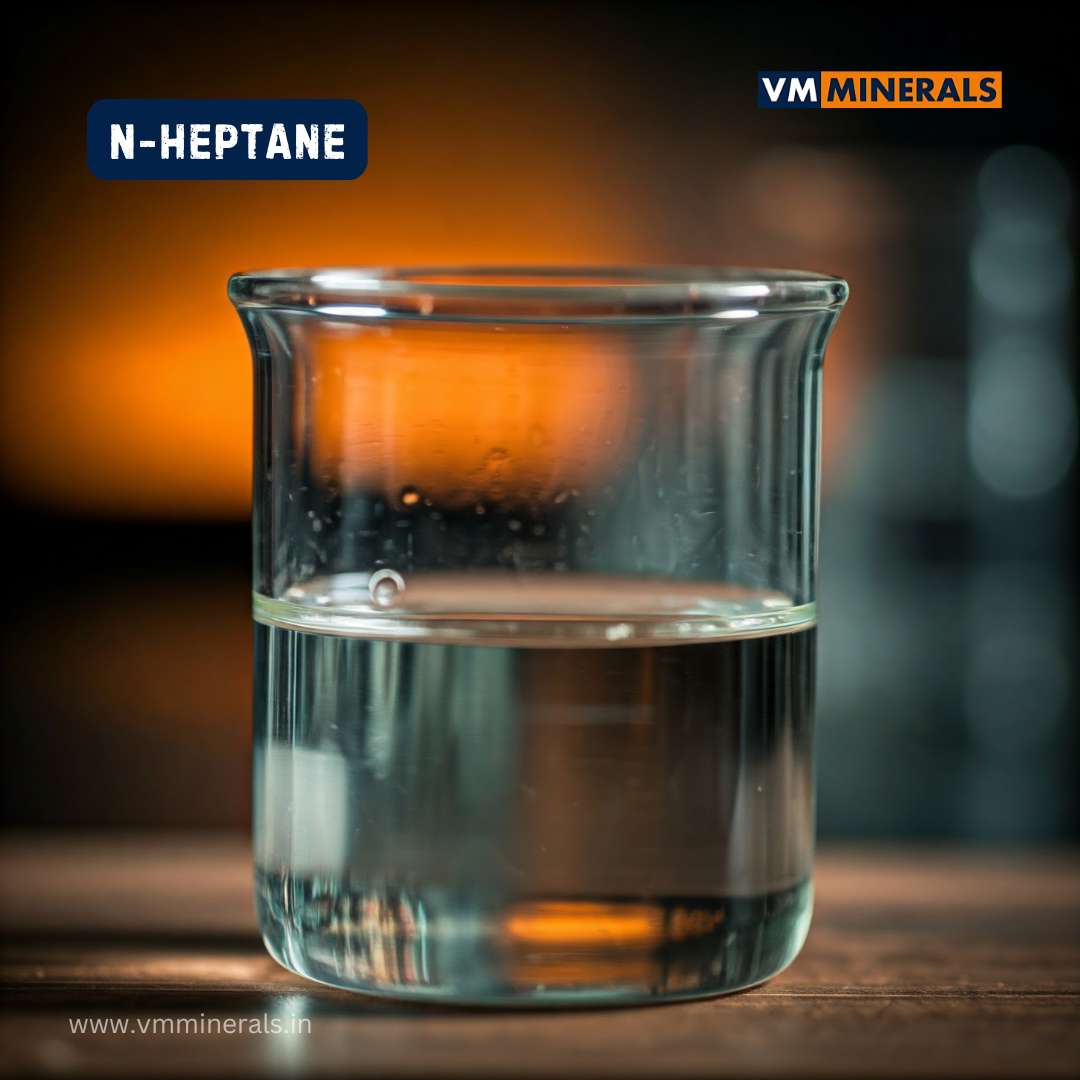N-Heptane by VM Minerals: Properties, Applications, and Safety
Introduction to N-Heptane
N-Heptane is a straight-chain alkane hydrocarbon with the chemical formula C₇H₁₆. It is a colourless, volatile liquid commonly used as a non-polar solvent in industrial and laboratory applications. As a reliable supplier, VM Minerals offers premium-quality n-heptane, meeting the needs of industries ranging from manufacturing to research laboratories.
N-Heptane Formula and Structure
What is the Formula of N-Heptane?
The molecular formula of n-heptane is C₇H₁₆, which signifies its composition of seven carbon atoms and sixteen hydrogen atoms.
Structural Representation of N-Heptane
The structure of n-heptane features a straight chain of seven carbon atoms fully saturated with hydrogen. It belongs to the alkane family, known for its stable and non-reactive nature.
Chemical Composition
N-Heptane is typically obtained through distillation of crude oil and serves as a reference compound in octane ratings for fuels.
Physical and Chemical Properties of N-Heptane
Boiling Point of N-Heptane
The boiling point of n-heptane is approximately 98.4°C (209.1°F), making it a moderately volatile solvent.
Other Physical Properties
- Molecular Weight: 100.21 g/mol
- Density: 0.684 g/cm³ at 20°C
- Melting Point: -90.6°C (-131.1°F)
- Appearance: Clear, colourless liquid
- Solubility: Insoluble in water but fully soluble in organic solvents like ether and ethanol.
Chemical Reactivity and Behaviour
N-Heptane is relatively non-reactive but combusts readily in the presence of oxygen, producing carbon dioxide and water.
Applications of N-Heptane
Use in Industrial Processes
N-Heptane is widely utilized as a solvent in:
- Pharmaceutical manufacturing
- Extraction processes
- Formulating rubber and adhesives
Role in Paint Thinners, Solvents, and Coatings
N-Heptane is a preferred solvent for:
- Paint thinners: Ensures smooth application and rapid drying.
- Coating formulations: Enhances viscosity and flow properties.
- Industrial cleaning agents: Effectively removes grease and oil.
Application in Laboratories for Testing and Research
N-Heptane is used in:
- Chromatography: Acts as a reference solvent for separation processes.
- Fuel testing: Serves as a primary standard for determining octane ratings in fuels.
Why Choose VM Minerals for N-Heptane?
High-Quality Standards
VM Minerals supplies premium-grade n-heptane that meets industry and laboratory specifications.
Consistent Supply Chain and Custom Solutions
We ensure on-time deliveries with the flexibility to meet custom requirements for large and small orders.
Excellent Customer Support and Expertise
Our experienced team provides comprehensive support, from product inquiries to technical guidance.
Safety and Storage Guidelines for N-Heptane
Health Hazards and Precautions
- Inhalation may cause dizziness, nausea, or respiratory irritation.
- Direct skin or eye contact may result in irritation.
- Use proper ventilation and personal protective equipment (PPE) when handling.
Safe Storage and Transportation Practices
- Store n-heptane in tightly sealed containers in a cool, well-ventilated area.
- Keep away from heat, open flames, and sources of ignition.
- Follow local regulations for transportation and disposal.
Environmental Impact of N-Heptane
Eco-Friendliness and Biodegradability
N-Heptane is less toxic and biodegradable under controlled conditions, making it a more sustainable choice.
Compliance with Environmental Standards
VM Minerals adheres to international environmental safety guidelines, ensuring minimal ecological impact.
Comparison of N-Heptane with Other Solvents
N-Heptane vs. N-Hexane
- N-Heptane: Safer alternative with lower toxicity.
- N-Hexane: Higher toxicity but widely used in industrial applications.
N-Heptane vs. Toluene
- N-Heptane: Non-aromatic, lower toxicity, and environmentally safer.
- Toluene: Aromatic solvent with stronger solvency properties but higher toxicity.
Reactions Involving N-Heptane
Combustion of N-Heptane
N-Heptane combusts completely to produce carbon dioxide and water.
Reaction:
C₇H₁₆ + 11O₂ → 7CO₂ + 8H₂O
N-Heptane in Hydrocarbon Cracking
N-Heptane can undergo cracking to produce smaller hydrocarbons, which are valuable in petrochemical industries.
Frequently Asked Questions (FAQs)
What is N-Heptane Used For?
N-Heptane is used as a solvent in paints, coatings, adhesives, and laboratories.
What is the Boiling Point of N-Heptane?
The boiling point of n-heptane is 98.4°C (209.1°F).
How Should N-Heptane Be Safely Stored?
Store it in a cool, well-ventilated area away from heat and ignition sources.
Is N-Heptane Environmentally Friendly?
N-Heptane is biodegradable and safer than many alternative solvents.
Why is N-Heptane Preferred in Testing Laboratories?
Its high purity and consistent performance make it ideal for fuel testing and chromatography.
How Does N-Heptane Compare to N-Hexane?
N-Heptane is a safer alternative with lower toxicity and similar solvent properties.
Specifications
| Parameter | Specification |
|---|---|
| Chemical Formula | C₇H₁₆ |
| Molecular Weight | 100.20 g/mol |
| Purity | ≥ 99.0% (varies by grade) |
| Appearance | Clear, colorless liquid |
| Odor | Mild, gasoline-like odor |
| Boiling Point | 98-99°C |
| Density | 0.683-0.685 g/cm³ at 20°C |
| Melting Point | -90.6°C |
| Flash Point | -4°C (closed cup) |
| Refractive Index | 1.385-1.387 at 20°C |
| Solubility | Insoluble in water; soluble in alcohol, ether, and chloroform |
| Vapor Pressure | 40 mmHg at 20°C |
| Acidity (as Acetic Acid) | ≤ 0.001% |
| Water Content (Karl Fischer) | ≤ 0.01% |
| Residue on Evaporation | ≤ 0.001% |
| Color (APHA) | ≤ 10 (for high-purity grades |
Trade Information
| Minimum order | 200 LTRS |
| Supply ability | Upto 50 MT per day |
| Delivery time | 48 Hrs. from the date of payment receipt |
| Payment terms | Advance payment before loading |
| Supply area | Tamil Nadu, Andhra Pradesh, Kerala, Karnataka & Telangana |
| Sample policy | Free samples are available |

